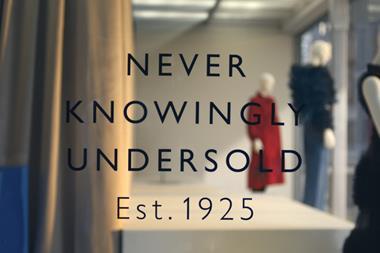10 years ago Retail Week’s headlines reflected online and value retail being in their infancy. At the start of the next decade, Sara McCorquodale examines what the sector can learn from the last one

Retail Week’s last issue of the 20th century heralded the arrival of huge shopping centres such as Bluewater and mammoth stores like Oxford Street’s Nike Town. Waterstone’s was opening a seven-storey location in London’s Piccadilly and Borders was becoming one of Oxford Street’s main attractions. But the same issue also forecast the internet would change the face of retailing in the wake of Amazon’s success.
Looking back from the beginning of 2010, there’s no doubt that retail has had a spectacular reinvention since the 21st century began.
As we predicted, the surge in etailing led bricks-and-mortar retailers online to ensure they got their share of the internet market. But it has been a tough decade for those left behind, with Borders’ rise and decline symbolic of an unforgiving decade for those retailers that failed to develop a multichannel proposition.
This is indicative not just of the economic downturn but of a change in what consumers want and how they want to shop. More than 60% of the population now has broadband in their homes and more than 90% have mobile phones.
Mintel director of retail Richard Perks says: “In general, the internet has probably been the thing that has changed the high street the most. 10 years ago it was absolutely tiny - quite insignificant. Who could have predicted Facebook a decade ago?”
John Lewis director of selling operations Nat Wakely echoes this view, saying: “It’s hard to believe we didn’t have any staff working on John Lewis Direct before 2001.”
Perks adds that while there have been benefits of online retailing, there have also been losses. “Major casualties of the internet are book and music retailers. They have really been taken over by etailers, especially since the recession began.
“Obvious examples of online retailers that have done well are Amazon and M and M Direct, but John Lewis has also done really well. It has completely adapted and moved with the times. Marks & Spencer is also worth mentioning. Both of these retailers have maintained a strong offline and online presence.”
Experian director of retail consultancy Jonathan de Mello agrees with Perks but believes retailers on the high street still have something distinctive to offer a decade on. “The internet forced retailers to raise their game and many have adapted marvellously. We’ve found retailers with bricks-and-mortar representation are still more likely to have customers visiting their website in addition to visiting stores.”
This view is supported by retailers’ experiences of customer habits. Red5 managing director Jonathan Elvidge says: “We are an online retailer and we have bricks and mortar - I feel like we have all bases covered. People will buy our products over the internet and come in-store. Of course the internet has changed things but we do feel like we are cornering the electricals gift and gadget market.”
The benefits of having both bricks-and-mortar and online presence cannot be contested in terms of strengthening a brand. But the ability of transactional websites to reach customers when retailers - particularly supermarkets - could not build more stores due to difficulties with planning permission has been a major triumph for the industry in the past decade.
Asda commercial director Emma Fox says: “It has been really important to us to ‘paint the map green’ - get as many stores opened and give as many customers Asda as possible.”
Yet she adds: “Some customers would say to us they had to travel 40 or 50 miles to get to us before the internet really took off. But now, they can just order online and we’ll drop it off at their house.”
In addition to launching transactional websites, retailers have also reacted to the growth of online by changing the way they interacted with customers.
“The development of internet communication, where retailers communicate with customers very transparently has been a huge change of the past decade,” says De Mello. “They have their competitors’ prices on their websites as well as their own. This is a long-term trend as far as I’m concerned.”
Customer knows best
Consumer interaction is something that has featured highly on the agenda for Asda over the past decade and is an area that it will continue to nurture. Fox says: “Customers want to take part in decision making now and get involved. This is something we have encouraged and something we want to expand. The power of the customer and the effect they can have on our stores is amazing.”
Argos managing director Sara Weller agrees, saying the internet has given the consumer a greater amount of command over the industry. “They demand and receive much more information about products, swapping opinions and knowledge with other customers,” she says. “As a result, the control retailers once had over the data flow has changed with customers able to hold the retailer to account more rapidly and with greater public authority.”
In general, shopping habits have not only changed the way retailers do business but have affected which retailers have had a major presence in centres and high streets across the UK.
Fashion retail has consolidated its dominance on the high street, while retailers have also responded to a growing passion for healthy and beauty products. In 2008 the market for toiletries and beauty products had grown 51% since 1998 and was worth £7.8bn. On average, a British adult spends £153 annually on health and beauty products.
De Mello says: “In the past decade, retail changed as a whole to become more fashion-oriented, even for guys.
In terms of the high street and shopping centres there has been an increase in health and beauty, clothing, jewellery and eating out.”
De Mello explains that now consumers demand shopping is more than a spending experience the allocation of property on the high street and shopping centres has also changed.
A decade ago the number of Starbucks, Pret a Manger and Eats peppering developments was tiny. However, in 2010, most of the bigger UK cities have more than one of these coffee shops on their major shopping streets.
“If you look at Westfield, about 25% of the space is dedicated to catering,” says De Mello. “And then look at the older places and they have eating out but they have fast food places like Burger King and KFC. Westfield has tried to develop shopping centre dining and make it more family-oriented.”
As the face of the high street and shopping centres have changed, the interiors of the individual stores have also undergone a transformation.
Retail Week stores editor John Ryan observes the shift from the minimalism that characterised interiors in the 1990s. He says: “By the end of the 1990s you could have taken the logo off the front of any shop and put it on the front of any other. They were all very similar. Now, more obviously in fashion, retailers have gone for colour and gone for this idea of lighting the stock, not the store.”
Ryan notes this technique was used most notably by Abercrombie & Fitch on Savile Row, London, in 2007.
“The whole thing about the prominence of stock and the stock being the star is very characteristic of the past decade,” he says.
For Ryan, the most memorable and significant moment for him in store design was the opening of the apple” class=”intextlink”>Apple Store on Regent Street in 2004.
He says: “I remember being outside of the store when it opened doing an interview with the BBC and some bloke from a rival electricals retailer saying ‘Very pretty, but it won’t work’.
“Some three or four years later, you walk into any Apple store and it is still mobbed. It has played a huge part in the renaissance of the Apple brand.”
Rewriting the landscape
In terms of retail developments for De Mello, the most significant schemes for him have been Bluewater for the longevity of its success and Birmingham’s Bullring. Speaking of the latter he says: “It has been extremely significant when you consider how it transformed the fortunes of Birmingham. Prior to the development, it had one department store but now it has Selfridges and retail is thriving.”
The question of what is next for retail hangs in the air as the second decade of the 21st century begins. The first saw the closure of Woolworths, Powerhouse, Zavvi, Threshers and The Pier to name but a few. And while the regional shopping centres have had a positive impact, many high streets now find themselves populated by discount and single-price retailers, that appear to be among the victors of the past decade.
As Weller says, the retail landscape is “polarised” by leisure developments and convenience supermarkets and pound shops.
Retailers like Primark have taken away any stigma previously attached to buying discount goods and as a result this section of the industry is thriving.
99p Stores commercial director Hussein Lalani says: “You can’t judge the past 10 years by the past eighteen months, but discount stores certainly seem to be the way retail is going.”
While the majority of retailers continue to develop their business across several channels, 99p Stores does not have a transactional website and does not intend to develop one.
“We don’t sell online and have no immediate plans to do so,” Lalani says. “Our best-selling item is the four-pack of kitchen roll. As you would expect, it costs 99p. I don’t think people are going to go online to buy that.”
Conversely, Wakely says John Lewis will move towards becoming increasingly multichannel and believes customers want one of two shopping experiences.
“They want to shop locally, have that convenience experience and get their goods quickly - this is why we launched our John Lewis Home concept in Poole this year,” he says. “Or they want that big shopping centre experience where everything is under one roof and it is a family day out.”
At Asda Fox wants to continue encouraging customer interaction and increasing the range of lines on offer. She says: “People want choice and diversity. We have a much bigger range now and sell more lines. The local lines we sell have been incredibly successful and we stock more ethnic and world food now.
“This is partially because there is more ethnicity in the population but also because customers are more adventurous and want more choice.”
BRC director-general Stephen Robertson believes that shoppers are returning to traditionalism, following a conversation with the chief executive of a supermarket who told him the business has distributed twice as many recipe leaflets in the past few months.
Meanwhile Perks believes we are about to witness a revolution in electricals goods retail due to the “complacency” of DSGi and the imminent arrival of Best Buy from the US.
The twists and turns ahead of an industry as dynamic and fast-paced as retail are hard to predict. The only certainty is that the pace of change will accelerate further.


























6 Readers' comments